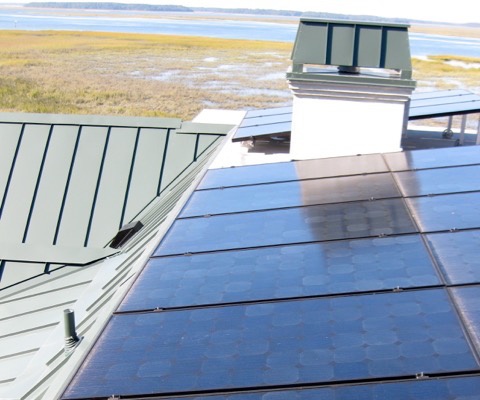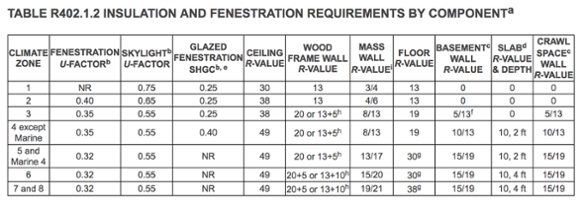Substituting Solar Panels for Insulation in the Energy Code

Supply and demand are two different things. When you think of an energy code, say the International Energy Conservation Code (IECC), you probably think of demand, not supply. Conserving energy, after all, means reducing demand. It’s related to supply only indirectly. As a result, you might expect an energy conservation code to have requirements that affect only the demand side of the equation. With the 2015 IECC, however, that’s not true anymore.
Relaxed building enclosure requirements with the ERI path
The 2015 IECC introduced a new pathway to compliance: the Energy Rating Index (ERI). It’s defined in a way that makes it pretty much the same as HERS Index, so home energy raters can help builders get their homes to comply. But there’s an important new element introduced into the IECC with the ERI path.
This index has a reference of 100 for a home designed to meet the 2006 IECC. Lower numbers are better. A home that just meets the 2009 IECC, for example, would come in at an index of about 85 or 90. The 2012 IECC drops that into the 70s. If you make the house as efficient as possible by building a Passive House, you’ll get down to an index of about 30.
The scale keeps going lower, however, and it’s possible to go all the way down to zero or even negative numbers. You get there by adding some on-site power production, usually rooftop solar. Throw some photovoltaic (PV) modules on the roof, and the house now produces some of the energy it uses. That production is included in the ERI calculation, so without some kind of backstop, home builders could leave out all of the things that make a home energy efficient — you know: insulation, air sealing, and little things like that.
Fortunately, the 2015 IECC did include a backstop. Here’s section R406.2:
R406.2 Mandatory requirements.
Compliance with this section requires that the provisions identified in Sections R401 through R404 labeled as “mandatory” and Section R403.5.3 be met. The building thermal envelope shall be greater than or equal to levels of efficiency and Solar Heat Gain Coefficient in Table 402.1.1 or 402.1.3 of the 2009 International Energy Conservation Code.
But this is in the 2015 IECC. And yes, that says the backstop is the 2009 IECC for building enclosure requirements. In climate zone 3, that would mean you could go back to R-13 walls instead of having to do either R-20 walls or R-13 cavity plus R-5 continuous. You could insulate ceilings to R-30 instead of R-38. You could put in windows with U-values of 0.5 instead of 0.3.
Here’s the table of building enclosure requirements for both the 2009 and 2015 energy codes. You can see what the difference might be in your climate zone. First the 2009 table:

And here’s the 2015 table:

There’s some serious relaxation of requirements in that statement.
Yeah, but would builders do it?
First of all, hitting the ERI numbers in the 2015 code isn’t easy. They vary from 51 to 55. which is significantly lower than the number achieved just by following the prescriptive path. Dropping back to the 2009 IECC requirements, the ERI without solar would be about 85. So they’d have to put on enough solar drop another 30 points. Is that possible? Yes.
We ran some numbers on a house we modeled here in Atlanta. It’s a 2,100 square feet, slab-on-grade, two-story house. The HERS Index was 73. When we added a 5 kilowatt PV system, a typical size, the HERS Index dropped to 38. That’s a reduction of 35 points, more than enough to get most homes to comply with the ERI path.
Even with the relaxed enclosure requirements, why would builders pay more to hit that lower number? The answer is that they might not have to pay more. The big players in the rooftop solar industry install their products for no cost sometimes. I heard a presentation by Solar City just last week, and they were telling the builders in the room about their free PV deal.
So there’s your answer. As a builder, you’d get to put in less insulation and cheaper windows. Then you get a lower ERI by getting the solar company to come in and install their stuff for free. Builders are business people. They understand profit. Why wouldn’t they take that deal?
Will this be fixed in the 2018 IECC?
This issue became a big deal in Florida this year during their code hearings. According to an article on the Code Watcher website, some at the Florida Building Commission were suggesting that the ERI calculation should exclude on-site power production entirely. After many hours of hearings, however, they reached a compromise. Rather than disallow any use of solar for energy code compliance, they set a new backstop. They changed from using the 2009 IECC as the minimum requirements to the 2015 IECC.
At the national level, the International Code Council (yes, I just said that) made some changes, too. First, they raised the ERI requirements for each climate zone. Those ERIs in the 2015 IECC ranged from 51 to 55. Now they’re 5 to 8 points higher. (Remember, a higher ERI means lower efficiency, so this makes it easier to achieve.) The other thing that got changed was the backstop. Just as Florida did, the IECC will now require the minimum enclosure levels in the 2015 IECC.
I’m fine with the relaxed ERI numbers. I thought the initial requirements were so low that few if any builders would choose that compliance path. The change in the backstop, though, is the really important one in my opinion.
This isn’t the end of the process. After the recent meetings in Kansas City, the voting members will vote again on the final changes. Assuming the changes I’ve described here get approved, the 2018 ERI compliance path will be a more robust option. And it may even get used.
Related Articles
Everything You Ever Wanted to Know about the HERS Index
Could an Energy Code Really Be So Simple?
The 2015 Energy Code Will Have a HERS Rating Compliance Path
The Three to Watch: 2018 IECC Public Comment Hearing [External]
Why You Shouldn’t Trade Thermal Envelope for Solar [External]
NOTE: Comments are moderated. Your comment will not appear below until approved.
This Post Has 7 Comments
Comments are closed.

Wow, just wow. So does this
Wow, just wow. So does this mean production builders are going to have to pay additional attention to design/orientation in order to meet the power generation requirements? Does the code even require that a PV array generate X-amount of power or could builders conceivably have an array pointing north and still meet the new requirements?
Production builders in CZ 2-4 must be thrilled because they can continue to utilize the absolute cheapest labor and use the cheapest materials.
On second thought I guess I shouldn’t be too upset since codes are voluntarily set by the State and my state is still married to 2009 IECC.
Kris, the ERI is one of four
Kris, the ERI is one of four compliance pathways. These changes may make it more appealing, but I expect a lot of builders will still follow the prescriptive path. Even if they choose the ERI path, they can hit their number just with efficiency if they want to.
Wow is right! Have we lost
Wow is right! Have we lost site of what seems to be becoming the future ultimate goal – – net zero? Even most existing homes can become net zero homes by undertaking a DER and adding on PV.
A new home built with an energy efficient building envelope can pretty easily become a net zero home by adding on PV. However, a new home that does not have an energy efficient building envelope may meet some arbitrary current code requirement, but will never become a net zero home – – unless it later has the additional expense of undergoing a DER.
Do we want to continue allowing production builders to build new “white elephants” for higher profitability, that will only cost others more later? Aren’t codes supposed to protect the homeowners safety and guarantee a sound building and, thus, a sound investment?
Why is it so hard for the
Why is it so hard for the building industry to understand that the sun doesn’t shine (much) when it’s coldest out.
Passive House levels of insulation are what’s needed to shave peak gas and electricity demand. In New England and Mid Atlantic gas demand peaks on cold winter nights because of heating demand and also because a lot of electricity generation is from gas peaker plants.
Substituting PV for insulation on a cold winter night is remarkable folly. That’s when households, and the grid, need insulation the most.
https://www.eia.gov/todayinenergy/detail.php?id=14671
Much of the discussion around energy transition is about energy storage (batteries, heat/cool storage) in order to shave the evening peaks by transferring daytime renewable energy to a storage medium. Passive House resolves that by storing heat, and not let it leak away… you know energy storage. And it also helps reduce peak electricity demand.
When will we be done with the net zero fetish?
The construction industry and
The construction industry and the code panels are losing sight of why we even have an energy code. The idea is to have a net savings of energy consumption and depletion of natural resources. Continuing to build poor performing homes and trying to offset with solar is worse than just building a moderately efficient house. The manufacturing process for poly silicon material is extremely energy intensive. While the cost of solar in financial terms has become much more affordable, the break even point in terms of energy produced as opposed to energy consumed in manufacturing is still many years. A good example is the Hemlock Semiconductor Corp. plant in Michigan. The HSC plant is the single largest consumer of electricity in the state, larger than any of the automobile plants. Solar can be part of the energy portfolio in areas where they get enough sunlight but they are not a replacement for common sense.
“While the cost of solar in
“While the cost of solar in financial terms has become much more affordable, the break even point in terms of energy produced as opposed to energy consumed in manufacturing is still many years.”
This only implies that there is an upper limit to how fast the industry can physically expand, as the lifecycle output is conservatively 10x the energy input. If we don’t expand the industry fast enough, we might get in a pickle with carbon pollution. Just because a manufacturing plant uses more energy doesn’t mean solar necessarily replaces common sense. In many areas throughout the country, the lack of common sense is discriminating against solar.
But to some extent, the solar
But to some extent, the solar power lowering the ERI is showing that efficiency matters less when there is an abundance of solar power available. With enough solar and thermal mass, the concept of R value may not matter so much for 1-2 story buildings. A solar panel produces 2-3x the annual kwh/sq.ft. than what a typical building uses and has an r-value of at least .9 but likely higher… Negative ERI means you are giving back green power to the community. Even if you increase your energy use in the process. The sun can provide 2000x more power than what we as humans use… and we have enough thermal mass on earth to store it!
If we forced companies to pay for carbon dumping, we wouldn’t need stupid energy ratings.